
With bids for the White House ramping up, policymakers are once again showing growing interest in the financing of higher education. The public is well aware of the rapid increases in college tuition (which are significant even when accounting for inflation), as the media continue to sound the alarm year after year. In an attempt to address this escalating problem, several presidential candidates have proposed substantial increases in funding for federal loans and grants.
In light of these proposals, one of which would increase federal aid funding by $100 billion over 10 years, we review the current state of affairs in higher education, the impact that increased federal aid has had so far, and whether more federal aid is the correct treatment for the problem of rising tuition prices. In order to assess the effectiveness of federal funding in support of aspiring college students, we review the existing literature and publicly available data. In addition, we examine the hypothesis that increases in federal aid funding for college students may actually be the primary driver of increases in tuition, rather than a way to lower costs for students as intended. The evidence broadly suggests that institutions of higher education are capturing need-based federal aid and responding to increased federal aid generosity by reducing institutional aid.
Rapidly Rising Tuitions Have Serious Adverse Effects
Adjusting for inflation, the average yearly tuition for full-time undergraduate students has risen from $3,610 in 1980 to $12,219 in 2016, an increase of some 238 percent—faster even than the rate of increase in healthcare prices over the same period.
Figure 1 displays the trend of average tuition levels since 1970. The data clearly show that tuition, in real terms, was not always high but was actually relatively affordable in the 1970s, fluctuating (although generally on a downward trajectory) between $3,000 and $4,000. However, since around 1980, tuition has been on an almost unbroken upward trajectory, with particularly rapid increases in the early 1980s, early 1990s, and the years following 2002.

As a result of increasing tuition, and with outstanding student loan debt for the country at more than $1.6 trillion in 2019, the burden of debt for students and graduates is an increasingly familiar problem and a foremost concern for most Americans—according to 2018 Pew polling data, 9 in 10 Americans say that college affordability is a very big or moderately big problem.
In 2018, Secretary of Education Betsy DeVos gave a speech in Atlanta in which she referred to the fact that nearly 20 percent of student loans are delinquent or in default as “a crisis in higher education.” Different measures of student loan default rates and repayment burdens uniformly show significant increases in recent decades across all types of institutions and students. Figure 2 shows that two-year cohort default rates increased more than twofold, from 4.5 percent in 2003 to 10 percent in 2011, while three-year cohort default rates have remained around 11 percent since 2012. (As required by the Higher Education Opportunity Act of 2008, the Department of Education [DOE] switched from a two-year to a three-year default measurement in 2012.)
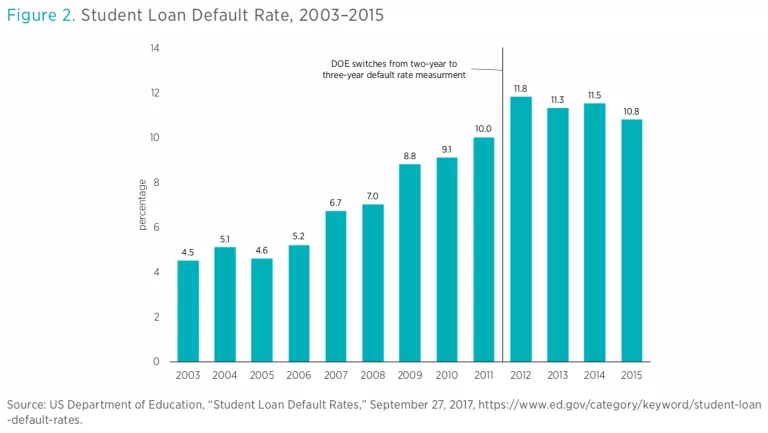
With the rising cost of debt repayments, rates of delinquency have been on a similarly upward trajectory in recent years. This has been driven in large part by students borrowing larger amounts and therefore accumulating more debt in both current- and constant-dollar terms. Figure 3 shows the percentage of student loans unpaid (delinquent) at 90 days or later. This rate started increasing from 7.1 percent in 2006, and since 2012 the rate of delinquency has fluctuated between 11 and 12 percent. What’s more, a study released in 2018 finds that students from low-income backgrounds disproportionately failed to repay their loans and that black borrowers were more than twice as likely to default on their loans as nonblack borrowers.
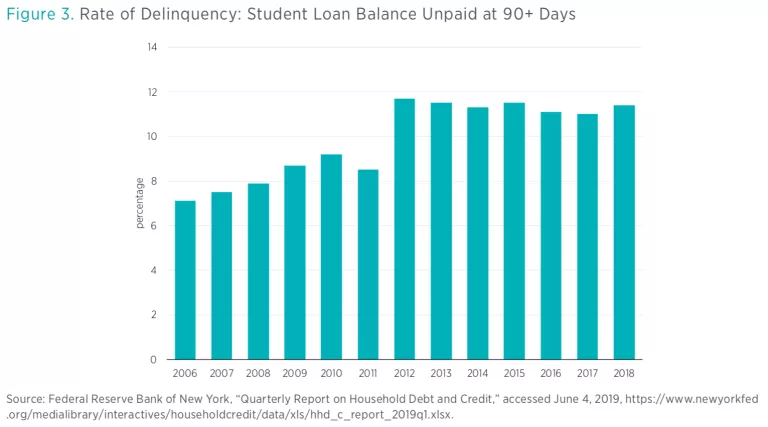
Has Increased Federal Aid Had the Desired Effect of Improving College Affordability?
In an attempt to address the escalating student debt crisis, some presidential candidates have begun advocating for significant expansions in federal student aid. In this section, we briefly assess the current system of federal aid before reviewing the existing literature about the effects of increased federal aid to college students. In light of the recent policy proposals, it is important to examine whether existing federal aid is having the desired effect of reducing the cost of attending college.
Notable changes in federal student aid policy began with the passage of the Middle Income Student Assistance Act (MISAA) in 1978. MISAA expanded eligibility for subsidized loans to all undergraduate students, regardless of financial need, and expanded eligibility for Pell Grants to middle-income students. For the 2019/20 academic year, students are eligible for Pell Grant funding if their expected family contribution (EFC) is less than $5,140. The DOE calculates all of families’ income and expenses to determine their EFC. There is no one income cutoff that makes a student eligible or ineligible to receive the Pell. The maximum Pell Grant awarded for the 2017/18 academic year was $5,920, and around one-third of undergraduates received Pell Grants.
Pell Grants were further expanded in the 1980s, and in the 1990s several new federal loans became available, from the Parent Loan for Undergraduate Students (PLUS) to unsubsidized Stafford Loans. Figure 4 shows federal and state student aid funding expanding significantly over time, from just under $3 billion in 1970 to just under $160 billion in 2017. The vast majority of this increased funding comprised expansions in federal loans and grants, which make up 86 percent of total government aid—an amount six times larger than state aid spending.
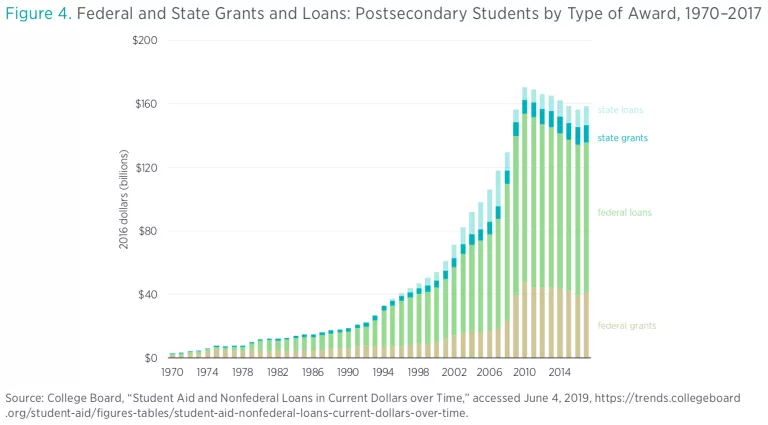
One often-overlooked form of education aid that policymakers rarely champion is institutional grant aid. Unlike loans, institutional aid does not need to be paid back by the recipient, and unlike federal aid, it imposes no cost on taxpayers. For private nonprofit educational institutions that charge $45,000 or less in tuition and fees, institutional aid is awarded based mostly on merit, while for educational institutions that charge more than $45,000 in tuition and fees, aid is awarded based mostly on need, with students from low-income families (families with incomes less than $35,000) receiving an average of more than $33,000 in institutional aid in the 2015/16 academic year. The importance of institutional aid in supporting highly talented and low-income students cannot be overstated—in the 2016/17 academic year, 44.7 percent of enrolled undergraduate students received an average of $10,774 in institutional aid. Considering that the average tuition for full-time undergraduate students in 2016 was $12,219, institutional aid plays a fundamental role in lowering net tuition costs for many talented and low-income students.
Increased eligibility over time has led to a large and growing proportion of college students who receive federal financial aid. Figure 5 shows the percentage of full-time undergraduate students awarded financial aid over time and displays the data for both two-year- and four-year-degree students. Also, figure 6 reveals a growing proportion of high school graduates enrolling in higher education over time, highlighting the importance of supply and demand and how subsidizing demand for higher education can increase college enrollment. The percentage of students awarded federal grants at four-year institutions was 65 percent at private for-profit universities and around one-third at private nonprofit and public institutions. For two-year institutions, the pattern is somewhat different, yet striking: 82 percent for private nonprofit institutions, 72 percent at for-profit institutions, and 53 percent for public institutions.
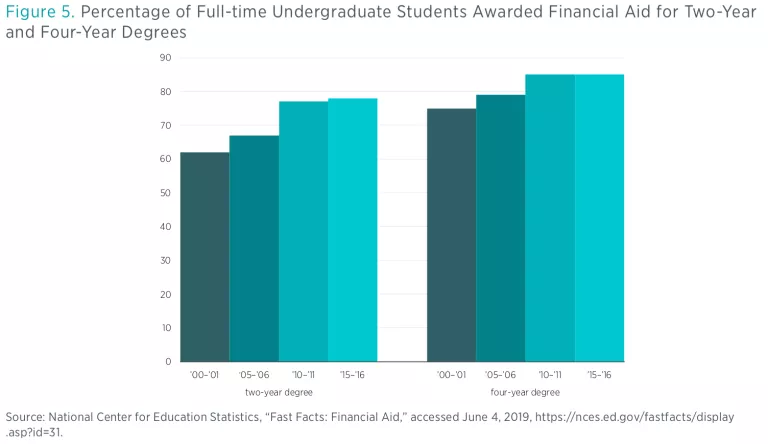
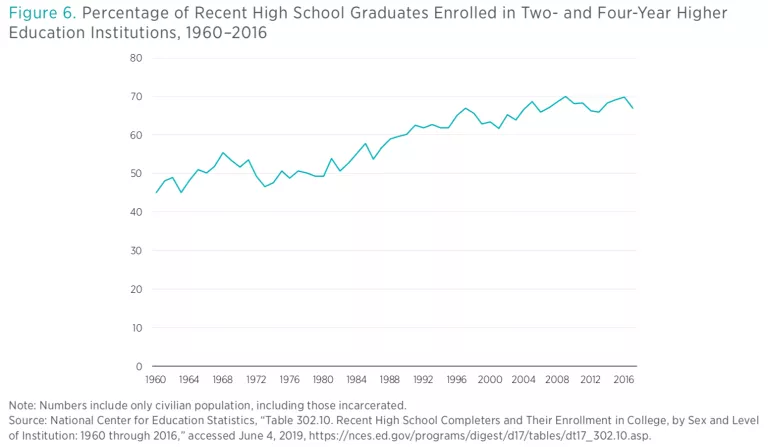
Owing to the vast expansions in federal student aid in recent decades in sync with escalating tuition costs and the subsequent student debt crisis, there is a growing strand of economic literature examining the relationship between federal aid and tuition prices. The question of whether increases in federal aid help or harm the financial status of students and graduates through changes in affordability was first asked by Secretary of Education William J. Bennett in 1987. Bennett wrote an op-ed in the New York Times titled “Our Greedy Colleges” in which he argued that, in reaction to increased federal aid, colleges had actually increased tuition costs. This became the basis for what many now term the “Bennett hypothesis.” Bennett was making the case that, contrary to the intentions of well-meaning policymakers, increased federal aid had made college less affordable; and that instead of improving accessibility, colleges had been using the extra revenues from aid to improve their prestige.
In a market economy, the demand for goods and services responds to prices. Government subsidies, which effectively lower the prices of goods or services, inevitably increase demand. Therefore, by subsidizing tuition through federal student aid, the government creates artificially high demand for college degrees, driving tuition prices higher and increasing the overall cost for students and taxpayers. As Bennett hypothesized, if education institutions are receiving greater federal funds and students are still being charged higher tuition and fees, then the educational institutions must be capturing part of the federal aid through increasing tuition. Policymakers’ solution to the issue of increasing costs has traditionally been to increase federal aid funding, which, as the hypothesis predicts, results in college getting ever more expensive over time.
Several studies have attempted to ascertain the validity of the relationship posited by Bennett. In order to account for the more recent surge in tuition, it is important that our analysis of the literature focus primarily on newer studies (published within the past decade). A study by Bradley Curs and Luciana Dar assesses whether institutions respond to state financial aid policies by changing net price. While this study is based on state aid, the economics behind the distributive consequences of financial aid policies are the same for federal aid. The study finds that both public and private institutions lower their listed tuition levels when states increase merit-based aid. Conversely, institutions actually raise tuition levels and reduce their institutional aid when the state increases need-based awards. These findings suggest two conclusions: (1) the institutions in this study are competing for high-ability students when awarding merit-based aid, and (2) they are capturing the increased state aid when that aid is based on need. The second conclusion of this study implies that as states increase aid funding based on need, institutions respond by capturing the increased generosity, thereby curtailing the ability of financial aid to improve affordability for low-income students.
Nicholas Turner examines whether increasing tax-funded federal student aid is an effective policy tool for increasing affordability for students at four-year colleges and universities. Turner finds that, contrary to the goal of policymakers, for every additional $1.00 of tax-based aid, institutional grant aid is reduced by $0.83, meaning that the intended cost reductions of federal aid are significantly offset by reductions in institutional aid. In order to account for the reduction in institutional aid, students react by increasing student loan borrowing. The overall results of the study imply that students who receive tax-funded aid are not fully benefiting through more affordable tuition.
Dennis Epple and his cauthors developed a general equilibrium model of the market for undergraduate higher education to examine the consequences of federal and state aid policies. Interestingly, their study finds that increased federal aid has different consequences for public colleges than for private colleges. In public colleges, of the $820 in increased average federal aid, $810 goes toward reducing costs for students. However, for private colleges, average student costs decline by only three-fourths of the increase in federal aid; the remaining 25 percent is captured in the form of increased revenue as institutions reduce aid in response to the subsequent increase in demand resulting from increased federal aid. What’s more, the crowding-out of institutional aid is notable—the model used by Epple and his coauthors predicts that a typical student receiving financial aid to attend a private college would find that almost 60 percent of the increase in federal aid is offset by reductions in institutional aid. Overall, the conclusions to be drawn from the study are that federal aid has moderate enrollment effects for public colleges, but it has negative enrollment effects on private colleges by crowding out institutional aid, substituting low-income and high-ability students for high-income and low-ability students. The authors conclude, “The increase in federal aid is passed along to poorer students in state colleges, but much of the increased federal aid is crowded out by reduced institutional aid in private colleges.” Perhaps these conclusions clarify that there are no all-encompassing policy prescriptions for improving college affordability, after accounting for differences in institutions and incentives.
A study by Stephanie Cellini and Claudia Goldin demonstrates strong support for the Bennett hypothesis. Using state administrative data, the study focuses on for-profit colleges, examining changes in tuition between institutions that are eligible to participate in federal aid programs and those that are ineligible. The study finds that for comparable full-time nondegree programs in the same field over 2005–2009, institutions that are eligible for federal aid raised tuition by about 78 percent more than institutions that are ineligible. When studying the case of short degree programs (fewer than 300 hours), the extra tuition charged by eligible institutions is nearly identical to the federal subsidy that the eligible institutions are receiving. The study notes, “The fact that the difference in tuition is about the amount of the subsidy should not be surprising because it is the result of an arbitrage condition. What matters to the consumer (in this case a student) is the net price: gross tuition minus the amount of the subsidy.” Not only do noneligible institutions survive without federal aid, the analysis of Cellini and Goldin implies that over time more students will be attracted to ineligible institutions because the lower tuition charged for similar programs of study offsets the subsidies—which not all students can qualify for anyway. These changing preferences largely owe to increased stringency eligibility for Pell Grants and subsidized loans. Students who lose eligibility for these federal aid programs will instead opt for the more affordable training offered by ineligible for-profit institutions. This is consistent with a variant of the Bennett hypothesis.
Another study that strongly supports the Bennett hypothesis is by Grey Gordon and Aaron Hedlund. Here the authors develop a quantitative model for higher education to test explanations for the steep rise in college tuition between 1987 and 2010. The study focuses on three drivers of increasing tuition during this time period: (1) underlying costs, (2) reforms to the Federal Student Loan Program (FSLP), and (3) changes in the college earnings premium. Changes in the FSLP alone generate a 102 percent increase; absent this demand-side shock variable, tuition increases only 16 percent. The rise in the college earnings premium causes tuition to increase by 24 percent, while supply-side shocks cause tuition to decline by 6 percent. These results reveal that increased federal aid is responsible for more than doubling the cost of tuition over a 23-year period (significantly more than any other factor), strongly supporting the Bennett hypothesis.
Eric Bettinger and Betsy Williams explore how states adjusted their need-based aid programs in response to the Great Recession and the federal aid policy set as a response thereto. The authors find that, holding costs constant, a $1 increase in Pell aid results in a $1 reduction in students’ state needs-based grants. When the growth in Pell aid was large, as it was during the Great Recession, then the growth in Pell aid might exceed growth in tuition. In such a case, the surplus aid would thereby reduce state need-based aid—the state program in this scenario demonstrates a negative correlation with Pell aid. The authors conclude that policymakers may need to shift their political rhetoric around Pell Grants, as advocating for endless expansions in federal Pell aid may be largely hollow.
Lesley Turner also authored a study that estimates the economic incidence of Pell Grants, concentrating on the pricing responses to increases in said aid. The study finds mixed results, largely depending on the type of institution: only one-fifth of Pell Grant recipients experience a decrease in net prices, as the pass-through of federal aid quickly replaces institutions’ willingness to offer assistance to needy students. Pell Grant recipients experience a 26 percent increase in institutional aid compared to nonrecipients, owing to the increased willingness of institutions to pay for needy students. However, every additional dollar of Pell aid is offset by a $0.19 reduction in institutional aid on average across all types of higher education institutions. The pass-through effect is far greater for private nonprofit institutions, with these institutions appropriating over two-thirds of their students’ Pell Grant aid. However, the study does note that the scope for capture of Pell Grant aid via tuition may be limited, and that on average, Pell Grant recipients receive at least $0.80 of each Pell Grant dollar.
David Lucca, Taylor Nadauld, and Karen Shen studied the effects of a student credit expansion on tuition costs in the academic years 2007/08 and 2008/09. Their study finds a pass-through effect on tuition of changes in subsidized loan maximums of about 60 cents on the dollar, and 20 cents on the dollar for unsubsidized federal loans. These results suggest that expansions in federal aid can affect tuition for a broad set of students, including those who are not recipients of federal aid. This is strongly supportive of the Bennett hypothesis.
The evidence broadly suggests that institutions of higher education are capturing need-based federal aid, with private colleges capturing as much as 25 percent of the increases in federal aid through reduced institutional aid. Higher education institutions respond to increased federal aid generosity by reducing institutional aid, so that for each dollar of additional federal aid they receive, students lose between 60 cents and 83 cents of institutional aid, depending on the type of aid and institution. During 2005–2009, colleges that are eligible for federal aid raised tuition by as much as 78 percent more than colleges that are not eligible for federal aid. Overall, increased federal student aid may be responsible for generating a 102 percent increase in tuition during 1987–2010.
Nationalization of Higher Education Is Not the Solution
To address the escalating student debt crisis, some presidential candidates have proposed the radical policy of nationalizing the higher education industry under the guise of “free college tuition.” While the effects of a higher education system based on free tuition are hypothetical for the United States, examples from other countries demonstrate the effects of free tuition on student enrollment, college accessibility, and educational quality.
Chile has moved toward a free tuition model in recent years. In 2014, the newly elected socialist government pledged to phase in free university tuition, first extending this benefit gradually based on family income, with the goal of covering students of all economic backgrounds by 2020. This makes Chile a real-time gauge of whether such policies have the desired effect of increasing affordability and accessibility. In a recent study on these changes in higher education in Chile, Alonso Bucarey finds that 20 percent of low-income students enrolled at the baseline would be denied admission under fixed college capacities, and with complementary policies that include investing in additional capacity, the enrollment rate of low-income students would drop by 10 percent. These findings demonstrate that, far from achieving increased affordability and accessibility, free college tuition actually pushes college further out of reach for the poorest students, owing to the increased competition for placement.
Behaving in almost the polar opposite way of Chile, England has, in just two decades, moved from a free college tuition system to one in which tuition is among the highest in the world. Contrary to what has been experienced in Chile, though, England has seen increased college enrollment and greater equity in higher education. In fact, a study by Richard Murphy, Judith Scott-Clayton, and Gil Wyness looks at the implications of moving from a system of free college tuition to a tuition-based market for quality, enrollment, and equity. The authors find that England’s shift has resulted in increased funding per head, rising enrollments, and a narrowing of the participation gap between advantaged and disadvantaged students.
Concluding Remarks
There is a student debt crisis in the United States that seems to be worsening. The burden of debt for millions of students and graduates is an increasingly familiar problem, with outstanding student loan debt for the country as a whole reaching more than $1.5 trillion by the end of 2018. Different measures of student loan default rates and repayment burdens uniformly show significant increases in recent decades, across all types of institutions and students. This has been particularly burdensome for those students from nontraditional backgrounds. At the same time that tuition has risen 238 percent, federal aid expenditure has risen from close to nothing to almost $160 billion a year, in sync with tuition costs.
In the coming months Americans can expect to hear presidential candidates advocate for significant expansions in federal student aid. The orthodox belief among policymakers is based on the assumption that increased federal student aid will alleviate rising tuition costs, thereby making college more affordable. As discussed earlier, the evidence reveals that federal student aid does not do much to make college more affordable and may actually be increasing costs.
Before making any sweeping policy proposals, policymakers should reconsider their support for significant expansions in federal student aid. Contrary to the argument that increases in federal aid will reduce the cost burden for students attending college, evidence suggests that students are suffering higher costs and debt burdens precisely because of expansions in federal aid. If federal aid funding continues to grow, higher education institutions may continue to capture this additional funding while increasing tuition and lowering institutional aid in response.
In addition to analyzing the effectiveness of federal funding of higher education, policymakers should explore why around 70 percent of high school graduates are choosing a college education over vocational education. With increasing costs and stagnating payoffs, this is a serious question. Policymakers should encourage apprenticeships, on-the-job training, and vocational education, supported by changes in federal laws and regulations.

